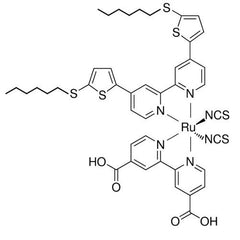A ruthenium bipyridine complex
applied as a dye for dye-sensitized solar cells
Specifications | MSDS | Literature and Reviews
C106 Dye is ruthenium complex dye developed for high-efficiency dye-sensitized solar cells (DSSC). Power conversion efficiencies of 11.7-12.1% have achieved in high-efficiency dye-sensitized solar cells under air-mass 1.5G simulated sunlights [1-5].
C106 Dye provides higher degree of conjugation to the ligand which in return enhances its overall optical absorption capacity. With hexyl groups enhancing its hydrophobic nature, C106 Dye not only increases electron donating property to the core of the metallic center, but also provides steric hindrance to minimize packing and agglomeration behavior thus higher overall device performance could be expected.
Ruthenium bipyridine complex
A high performance dyes used in DSSCs
Worldwide shipping
Quick and reliable shipping
Enhances electron donating property
improve overall device performance
Hexyl group provide steric hindrance
minimzing packing and agglomoration
General Information
| Full name | Cis-Bis(isothiocyanato)(2,2′-bipyridyl-4,4′-dicarboxylato)(4,4′-bis(5-(hexylthio)thiophen-2-yl)-2,2′-bipyridyl)ruthenium(II) |
| Synonyms | C106 Dye |
| Chemical formula | C44H44N6O4RuS6 |
| Molecular weight | 1014.32 |
| CAS number | 1152310-69-4 |
| HOMO / LUMO | HOMO = -5.05 eV, LUMO = -3.38 eV |
| Solubility | Acetonitrile and tert-butyl alcohol (volume ratio: 1/1) [1] |
| Classification / Family | Transition metal complex, Ruthenium complex, Bipyridyl ligands, Energy materials, Dye-sensitized solar cells DSSC) materials, Donor materials, OPV materials. |

Product Details
| Purity | >85.0% (HPLC) |
| Melting point | 196 °C (lit.) |
| Appearance | Black powder |
MSDS Documentation
Literature and Reviews
-
Dye-Sensitized Solar Cells with a High Absorptivity Ruthenium Sensitizer Featuring a
2-(Hexylthio)thiophene Conjugated Bipyridine, Y Cao et al., J. Phys. Chem. C, 113, 6290–6297 (2009); DOI: 10.1021/jp9006872. - A selective co-sensitization approach to increase photon conversion efficiency and electron lifetime in dye-sensitized solar cells, L. H. Nguyen et al., Phys. Chem. Chem. Phys., 14, 16182-16186 (2012); DOI: 10.1039/C2CP42959D.
- High-Efficiency Dye-Sensitized Solar Cells: The Influence of Lithium Ions on Exciton Dissociation, Charge Recombination, and Surface States, Q. Yu et al., ACS Nano, 4 (10), 6032–6038 (2010); DOI: 10.1021/nn101384e.
